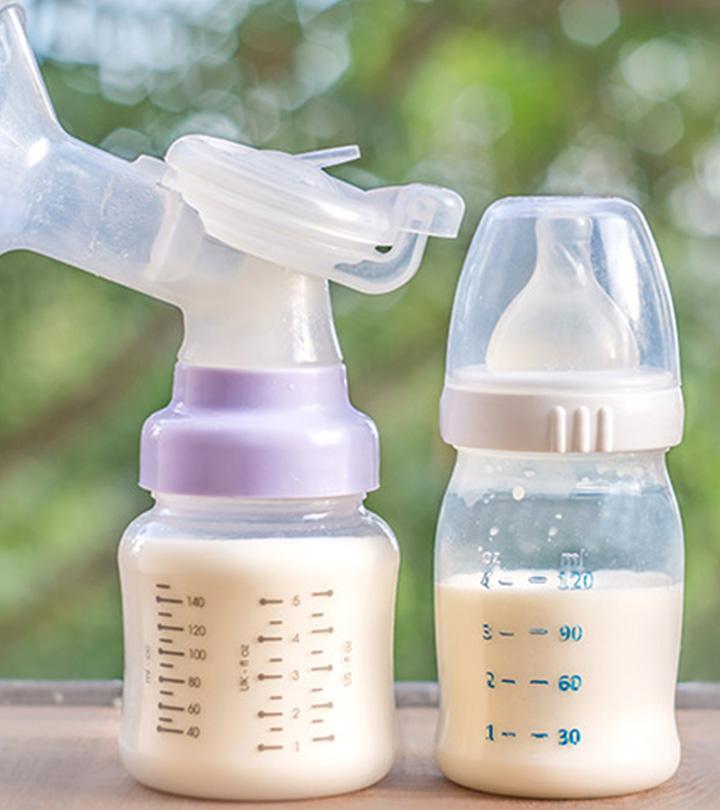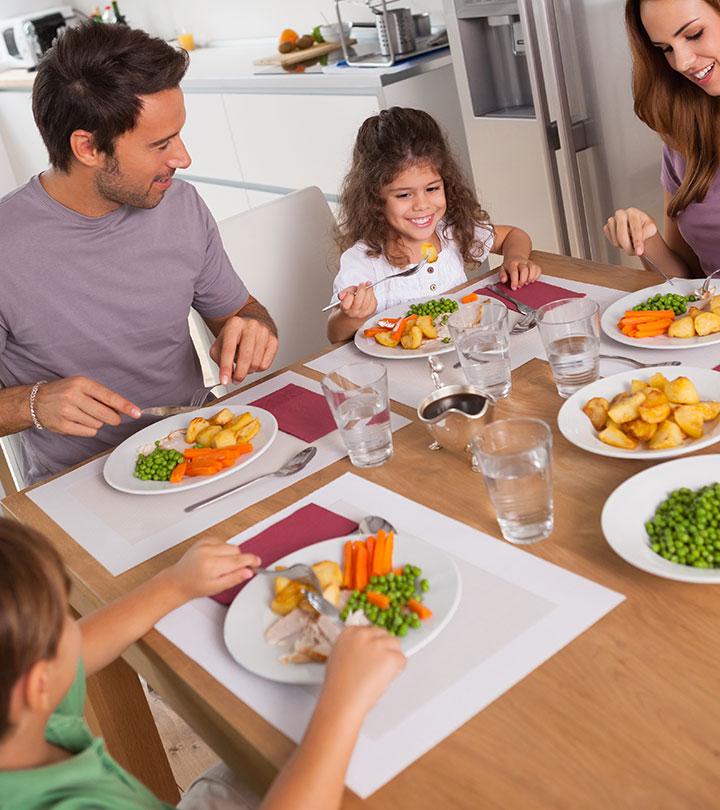
Image: Midjourney/ MomJunction Design Team
Once your baby reaches six months of age, you need to reduce the share of breast milk and gradually introduce solids in their diet. A fruit puree for babies is a great way to start this transition. Breast milk is a great source of nutrition, and hence the substitute foods should be highly nutritious to fulfill the baby’s needs for healthy, all-round growth. In addition, the baby will not be able to consume foods that are difficult to gulp or digest. As per the data from the Centers for Disease Control and Prevention and the Health Resources and Services Administration, it was observed that a significant proportion of children aged 1 to 5 (approximately 32.1%) in the year 2021 did not consume fruits on a daily basis. To cultivate a favorable association with fruits, including fruit puree in your baby’s dietary regimen can prove beneficial. Fruit purees are easy to prepare. They are tasty and packed with essential vitamins and other nutrients. Read on the post for some simple fruit puree recipes that your baby will love eating. We have also added some tips on making purees and introducing them to your little ones.
Key Pointers
- Fruit purees not only take care of the nutritional needs of the baby, but are also easy to make and store.
- The desired fruit can be steamed and mashed with some formula or breast milk to get the right consistency.
- Fruits such as apples, bananas, peaches, pears, and mangoes are good options for purees.
- A single or a combination of a variety of fruits may be served as infant solid foods.
- These purees can be made from store-bought fruit; however, additives such as sugar and other sweeteners should be avoided
5 Tips To Make Fruit Puree For Babies
Knowing a few ways to puree the fruits will make your task easier:
- Steam the fruits as it preserves the nutrients in the fruit pulp and helps you serve as wholesome food in the early days of weaning.
- After steaming, you can mash the fruit with a little breastmilk or formula.
- Do not cook soft fruits such as banana, avocado, and kiwi. Just puree them with some water in a processor.
- Make sure the puree consistency is runny in the initial days, and reduce the water quantity eventually.
- Puree the fruits in a blender or food processor. If you believe in pureeing the traditional way, a fork will suffice.
Store homemade fruit purees in airtight containers in the refrigerator for up to two days, or freeze them in ice cube trays for up to a month. Thaw in the fridge before serving, and do not refreeze.
Nutritional Benefits Of Fruit Purees
Introducing fruit purees to your baby’s diet provides several nutritional benefits (1):
- Vitamins and minerals: Fruit purees provide vital nutrients such as vitamin C (supports immunity), potassium (aids muscle and nerve function), and vitamin A (promotes eye health).
- Dietary fiber: They contain fiber, which aids digestion and helps prevent constipation in infants starting solid foods.
- Antioxidants: Fruits contain antioxidants that protect cells and promote overall health.
- Hydration: Many fruits have high water content, assisting in keeping your baby hydrated.
Although fruit purees are beneficial, they should be part of a balanced diet. Introduce new foods gradually, and always consult your pediatrician for personalized feeding advice.
Infographic: Points to Remember When Making Fruit Puree For Babies

Illustration: Momjunction Design Team
 Quick tip
Quick tipHow To Introduce Fruit Purees To Babies?
Remember, your baby will not be able to digest solids immediately after introducing them. So do not introduce a variety of foods at a time.
Follow the 3-Day Wait Rule to introduce new foods so that any intolerance or allergic reaction to a particular food can be known:
- Start with one tablespoon one time a day on day one.
- Increase it to two tablespoons twice a day on day two.
- Make it three tablespoons twice a day on day three.
This practice helps identify which foods may cause issues, ensuring the baby’s safety as they explore new flavors. Once the baby adjusts to the fruit’s taste and digestibility, you may add it to plain yogurt to make delectable fruit smoothies. Alternatively, you may use different fruits to make homemade fruit jam or spread.
Now, let’s see the various fruit purees you can offer to your baby.
Fruit Puree Food Recipes For Babies
Here is our list of easy-to-make fruit puree recipes you can try making for your baby.
1. Apple Puree for Baby:

Sweet, cooked apples are great as early foods. They are easily digestible and unlikely to cause any allergies. You can give them from the fifth or sixth month.
You will need:
- Apple – 1/2
- Cinnamon – a pinch
How to:
- Peel and core the freshly washed apple fruit.
- Cut it in half and take the required quantity.
- Cook the apple by any of the below methods:
- Steam the fruit using a steamer.
- Keep the apple chunks in a bowl and pressure cook it with water. Cook for three whistles.
- Add apple chunks in a thick-bottomed pan filled with water. Cover and cook until you get the desired consistency.
- Once the apple is cooked, mash it using a spoon or masher or blender.
- Add breastmilk or formula to make it runny. Avoid adding water.
- Add the contents in a sterile feeding bowl and serve. You may add cinnamon.
2. Banana Puree:

You may introduce bananas as early as four months, but the recommended age to begin solids is six months. They are the ultimate weaning food for babies: easy to peel and prepare. Moreover, they provide significant amounts of energy.
You will need:
- Ripe banana – 1 small
- Water, breastmilk or formula feed – as required
How to:
- Peel and cut a banana into small pieces.
- Mash using a fork, or you may puree it in a blender or food processor.
- Add some breast milk, formula, or water to make a thin consistency.
- Serve it fresh.
3. Apple and Banana Puree:

Get the best of apple and banana through this recipe. Moreover, banana is ideal for constipation and other digestive problems.
You will need:
- Apples – 2 whole (sweet)
- Banana – 1 full (ripe)
How to:
- Peel the skin and cut the apples into small chunks.
- Chop the peeled banana into small pieces.
- Keep them in a thick-bottomed pan, bring to a boil and leave until they get soft.
- Puree them in a blender to required consistency.
- You can also add breastmilk or formula feed to make it runny.
4. Mango Puree for Babies:

Mangoes may pose allergic risks in some babies. Therefore, make sure that your baby does not develop any allergies with mango. You may give the fruit after six months of age, and follow the 3-day rule.
You will need:
- Ripe mango
How to:
- Wash the fruit and peel the skin.
- Cut it in half and remove the seed. One-half can make enough puree for your little one.
- Cut into small chunks, and mash them using a fork or in a blender.
- Serve this fruit mash plain. You can also mix it with other fruits, oatmeal or full-fat yogurt.
- Store the leftover mashed fruit in an airtight container for later use.
You can also add other healthy ingredients and vegetables to make this mango puree recipe more nourishing for the baby. Debjani Moitra is a mother, a foodie, and an avid blogger. Sharing the recipe and some tips when making this baby food, she says, “I use the organic mango frozen bag from Costco. They are peeled and cubed, so they are easier to add to any puree. I think it is wonderful to keep introducing more and more different types of food to babies at this age… This combo of sweet potatoes, peas, butternut squash, and mango is delicious and nutritious, loved and approved by baby Prisha (my daughter) (i).
5. Banana and Mango Puree:

Tropical mango and banana are mellow on your baby’s tummy. This combination would be a great addition from six months and up.
You will need:
- Banana – 1
- Mango – 1 (small-sized)
How to:
- Peel the mango and banana, and cut them into small chunks.
- Transfer all the pieces to a food processor or blender.
- Process until the mix or fruit blend turns smooth.
- Add a little water, breastmilk, or formula to thin the puree.
- Serve immediately or freeze for later.
6. Avocado Baby Food Puree:

Avocados are excellent sources of unsaturated fats and vitamin E. This can be given from six months.
You will need:
- Ripe Avocado – half fruit
How to:
- Peel and remove the pit of the fruit.
- Scoop its contents and do not cook.
- Mash the meat using a fork or a blender.
- Serve the freshly prepared puree.
You may also add a banana for taste or milk for thinner consistency.
 Health fact
Health fact7. Quinoa, Banana, Apple and Dates Puree for Babies:

Quinoa is a gluten-free grain and superfood. When added to the list of your baby’s food menu, she cannot resist this delicious puree.
You will need:
- Quinoa – 1 cup
- Banana – 1
- Apple – 1
- Dates – 4 to 6 soft
- Cinnamon – a pinch (optional)
How to:
- Wash the quinoa well to remove bitterness.
- Bring two cups of water to boil and add quinoa. Leave for about seven minutes on a medium flame.
- Peel and cut the apple into small pieces, cut soft dates and add them to quinoa. Leave for 20 – 30 minutes.
- Once the above ingredients are cooked, you may blend or make a puree; add mashed banana and a pinch of cinnamon powder if you require.
- You can either serve it like that or add milk for a thin consistency.
- Freeze the remaining puree to use it later.
8. Peach Puree:

Peaches contain abundant beta-carotene and potassium. Here is our method on how to puree frozen or fresh peaches.
You will need:
- Ripe peach – 2
How to:
- Wash the peaches using a 3:1 ratio of water and vinegar to remove any bacteria. Rinse again under cool water and dry.
- Boil water in a medium-sized saucepan, add peaches and leave for 45 seconds.
- Remove the peaches and put into an ice bath immediately.
- Once the fruits are fully submerged, peel their skin. Slice them half and remove their pit. Now slice each half into even sized pieces.
- Puree the slices in a blender or a food processor until you get a smooth consistency. Add the required amount of water to make it runny.
- Serve the sweet and mild tasting peach puree to your baby.
9. Nectarine puree:

Rich in vitamins A and C, nectarines are similar to peaches and make a delicious fruit puree for the baby.
You will need:
- Ripe nectarine – 2
How to:
- Wash the nectarines using water and vinegar in a 3:1 ratio. Run them under cool water and dry.
- Boil water in a saucepan, add nectarines and leave for 45 seconds.
- Remove them and put the fruits into an ice bath or cold water.
- Once they are fully submerged in water, peel the skin. Pit and slice them into small pieces.
- Puree the pieces in a blender or food processor for a smooth consistency. Add water to make a thin puree.
- Serve the sweet and mild flavored puree. You can refrigerate the leftover nectarine puree.
10. Plum Puree:

Plums are rich in dietary fiber, which is a natural cure for constipation. It has a pleasing combination of tart and sweet flavors.
You will need:
- Pitted prunes or fresh plums – 6
How to:
- Wash fresh plums using a mixture of three parts water and one part vinegar. Clean under running water and dry.
- Add plums into boiled water and leave for some 45 seconds. Remove them and add into an ice bath or cold water immediately.
- After the plums submerge completely in water, remove and peel them using a sharp knife or fingers. Pit and cut them into small chunks.
- Puree the chunks in a blender or a food processor. You can also add water for the desired consistency.
- Sweet and mild tasting plum puree is ready to serve.
- Follow the same steps to make prune puree for babies.
11. Kiwi puree:

Kiwi fruit is rich in fiber and vitamins A and C. However, its acidic nature could cause diaper rash or mouth rash in babies. Therefore, take care to notice any signs of allergy when you give it to the baby for the first time. You may give this fruit after six months.
You will need:
- Kiwi fruit – 1
How to:
- Peel the fruit and cut into small slices.
- The fruit need not be cooked or de-seeded.
- Mash or puree the pieces in a blender or a food processor.
- Serve the freshly prepared kiwi fruit puree.
12. Chikoo or Sapota or Sapodilla puree:

The fruit is rich in fiber and vitamins A and C. It is good for digestion, effective against cold and cough, and promotes healthy immune system in babies. It can be given after seven months of age.
You will need:
- Chikoo – 1
How to:
- Cut the fruit into two halves, and remove seeds.
- Mash it using a fork or in a food processor.
- You can add a little breastmilk or formula feed to improve its taste.
13. Papaya puree:

Luscious and sweet papayas are filled with high amounts of folate, fiber, and vitamins A, C and E. You can introduce it as a later first food around seven to eight months of age.
You will need:
- Ripe papaya, which has dark yellow and orange hue on the skin, and is free of blemishes.
How to:
- Wash papaya with water and vinegar mixture to remove any bacteria. Rinse under running water and pat dry.
- Peel and slice the papaya in half and scoop out the seeds. Wash again to remove the leftover seed residue.
- Cut the fruit into pieces, and puree it. You may add water depending on the consistency you want to make.
- Serve the plain papaya puree to your baby.
14. Guava puree:

Guava is rich in vitamin C and helps improve the immune system. The dietary fiber in the fruit boosts digestive health.
You will need:
- Ripe guava – 1
How to:
- Cut the fruit into two halves.
- Remove the seeds using a spoon.
- Now cut the fruit into small pieces and take in a saucepan. Add some water, cover with a lid and keep in simmer until it is cooked.
- Pierce a knife to check whether it is cooked.
- Puree them in a blender. Add water to get the desired consistency.
- Take the puree into a sterilized bowl and serve your baby.
15. Dates puree:

Dates are a superfood to include in your baby’s diet. However, you cannot offer dates in their whole form to babies. So puree dates and mix a spoonful with other baby foods or milkshakes. Date puree is a dry fruit concentrate that can be a good option to add sweet fruit flavor to different foods.
You will need:
- Dates – 15 to 20 (deseeded)
- Water – 1 cup
How to:
- Add dates along with water in a saucepan. Let the mixture boil, and keep in simmer for about 10 minutes.
- Cool the mixture and blend it until you get a smooth consistency.
- Strain and again heat and cook till the puree thickens.
- Cool the mixture and store in an air-tight container for a week or more.
- You can add this organic fruit puree to sweeten any of your baby’s foods.
 Quick tip
Quick tip16. Apple and Raspberry Puree:

Raspberries have a sweet and delicate flavor. You can make this homemade fruit puree or fruit conserve during the raspberry season. It offers abundant vitamin C for your baby.
You will need:
- Raspberries – 100 grams
- Apple – 1 large fruit
How to:
- Peel the apple, remove the core and cut into pieces.
- Put the apple pieces and raspberries in a saucepan with a little amount of water.
- Cook for five minutes over a low heat until they turn soft.
- Puree the ingredients and run through a sieve to remove raspberry seeds.
- Serve it warm to your little one.
- You can use this puree in thick form as a fruit spread for older babies and toddlers.
17. Avocado and Banana Puree:

This combination need not require cooking as both are soft fruits. They offer enough amounts of healthy fat and potassium to your baby.
You will need:
- Ripe banana – 1/2 small
- Ripe avocado – 1/4 small
- Breastmilk or Greek yogurt – 1 or 2tbsp
How to:
- Peel and remove avocado pit. Likewise, peel the banana.
- Mash them together in a blender or food processor.
- Add required milk or yogurt to make it runny.
- You may also substitute avocado to make a delicious variant of this natural fruit puree.
18. Blueberry Baby Food Puree:

An antioxidant-packed superfood, blueberries make a great meal for babies with their pleasant taste. They are stage two foods, which can only be offered after eight months of age.
You will need:
- Blueberries – 1 cup (fresh or frozen)
- Water – 1/2 cup
How to:
- Boil water in a saucepan.
- Add blueberries and keep in simmer for about 15 minutes. Frozen berries take more time to cook. Keep them until they turn soft.
- Now transfer the boiled berries into blender and puree to required consistency.
- Serve it fresh, and you can freeze it for three days.
- Add baby cereal to make it thick.
19. Tropical fruit puree:

Banana, mango. and papaya make this vitamin-packed tropical puree suitable for your baby from six months of age.
You will need:
- Banana – 1 whole
- Mango – 200gm
- Papaya – 200gm
How to:
- Peel and cut the mango into small pieces.
- Peel papaya, remove the seeds and scoop out the fruit.
- Peel and slice the banana.
- Put all these in a blender and puree to a required consistency.
- Add water or breastmilk to make it smooth.
- Serve fresh tropical puree to your baby and see them enjoy the fruit flavor.
20. Summer berry puree:

Berry puree, including all those top-notch berries, is tasty and full of flavor. It can be a wonderful treat filled with antioxidants and vitamins from six months and above.
You will need:
- Strawberries – 100gm (fresh or frozen)
- Raspberries – 100gm (fresh or frozen)
- Blueberries – 100gm (fresh or frozen)
How to:
- If the fruits are fresh, then wash and clean them to remove any stalks. If frozen, defrost them following the instructions on the packet.
- Combine all the berries and put them in a mixer or blender.
- Puree until you get a required consistency.
- Pass the puree through a fine sieve to remove small seeds.
- Serve the freshly made berry mash to your baby.
21. Pear puree

Pear puree is a simple baby food that can be helpful for your little one’s digestive system. Follow this recipe to give this nutritious fruit to your baby.
You will need:
- Four cups of diced pears (riped)
How to:
- Get a pot and boil 1 cup of water. Put in the pears and turn down the heat a bit. Cover it up and let it cook for around 15 minutes until the pears are super soft when you poke them with a fork.
- Use a slotted spoon to move the pears into a blender. Pour in ½ cup of the water you used for cooking into the blender and blend it. If it’s too thick, add a bit more water.
- Let it cool, and you’re ready to eat or save it for later.
These simple baby fruit puree recipes will help you begin with weaning the baby. The choices are not limited to a few. You may experiment with any combination of fruits and vegetables and mix them with oatmeal or yogurt or make a fruit spread provided they blend well with each other and do not pose an allergy risk to the baby.
However, here is a word of caution:
Frequently Asked Questions
1. What are some of the best fruit purees for babies to start with?
Smooth textured and ripened fruits such as bananas, apples, papaya, and pear are some of the great choices to prepare purees for young infants (2).
2. Are there any fruits babies should not eat?
It is best to avoid serving hard and raw fruits such as apples and unchopped grapes for babies below one year as they might increase the risk of choking (3).
3. What fruit purees can be mixed for babies?
Initially (when beginning solids), you must avoid serving a mix of purees (such as apples and pears) to babies. Nevertheless, as they learn to enjoy a greater variety of tastes and textures (with age), you may try mixing two purees or a combination of suitable fruits (4).
4. Are fruit purees healthy for my baby?
Hannah Whittaker, a pediatric and pregnancy dietitian from Liverpool, England, says, “Fruit puree is a great way to start weaning; however, as babies grow, I would recommend introducing a variety of fruits. Also, I suggest giving soft pieces of finger foods alongside fruit puree to support the baby’s development.”
5. Can I give my baby apples everyday?
“I wouldn’t recommend sticking to the same foods daily. Instead, I advise parents to provide a variety of tastes and textures. You may add variation to fruit purees through spices; for example, adding a small amount of cinnamon to apple puree for your baby will change the flavor and expose the baby to a different taste,” Whittaker suggests.
6. What to do if my baby refuses fruit purees?
If your baby refuses fruit purees, try offering a variety of fruits and textures, mix the puree with familiar foods, or model by eating the fruit yourself. Be patient and keep trying, as babies often need several attempts to accept new foods.
7. How can I tell if my baby is allergic to fruit?
Signs of fruit allergies may appear within minutes to a few hours after eating. Some common symptoms include hives, itching, swelling (especially of the face, tongue, or lips), vomiting, coughing, or difficulty breathing (1). If you notice these symptoms, stop feeding the fruit and consult your pediatrician.
Fruits offer great health benefits and are the first choice for a baby’s weaning diet. If you plan to include fruit puree for babies as a part of their weaning diet, wait till they reach six months. These simple fruit puree recipes could help you pick the most suitable meal to initiate weaning. You may also try fruit and vegetable combinations and customize the recipe as per your baby’s preferences. However, always consult your baby’s pediatrician before introducing fruit purees to your baby, specifically if they are allergic to any fruit.
Illustration: Amazingly Healthy And Tasty Fruit Purees For Babies

Image: Stable Diffusion/MomJunction Design Team
Welcome to the world of homemade baby food! Learn how to make delicious vegetable and fruit purees for your 6-10 month old baby. Let’s get started!
Personal Experience: Source
MomJunction articles include first-hand experiences to provide you with better insights through real-life narratives. Here are the sources of personal accounts referenced in this article.
i. Life without alu?https://lifewithoutalu.blogspot.com/2021/03/sweet-potatoes-peas-butternut-squash.html
References
- Joanne L. Slavin and Beate Lloyd; (2012); Health Benefits of Fruits and Vegetables.
https://www.ncbi.nlm.nih.gov/pmc/articles/PMC3649719/ - Healthy Eating for 6 to 24 month old children; Getting Started.
https://www.fhs.gov.hk/english/health_info/child/14727.html - Do’s and Don’ts for Baby’s First Foods.
https://www.eatright.org/health/pregnancy/babys-first-foods/dos-and-donts-for-babys-first-foods - Feeding Your 4- to 7-Month-Old.
https://kidshealth.org/en/parents/feed47m.html - 10 Tips for Starting Your Baby on Solid Food.
https://www.peps.org/ParentResources/by-topic/feeding/10-tips-for-starting-your-baby-on-solid-food - Avocado for Babies.
https://extension.colostate.edu/topic-areas/family-home-consumer/family-matters-newsletter/family-matters-newsletter-february-2019/ - Babies and Food Allergies.
https://www.chla.org/blog/advice-experts/babies-and-food-allergies
Community Experiences
Join the conversation and become a part of our nurturing community! Share your stories, experiences, and insights to connect with fellow parents.
Read full bio of Charmaine Dominguez
- Hannah Whittaker is an expert pregnancy and pediatric dietitian with nearly 20 years of experience, the last 7 years as a registered dietitian. She manages her private practice Bump2baby Nutrition in the UK, having done her graduation in community nutrition and dietetics from Liverpool John Moores University & University of Chester respectively.
 Hannah Whittaker is an expert pregnancy and pediatric dietitian with nearly 20 years of experience, the last 7 years as a registered dietitian. She manages her private practice Bump2baby Nutrition in the UK, having done her graduation in community nutrition and dietetics from Liverpool John Moores University & University of Chester respectively.
Hannah Whittaker is an expert pregnancy and pediatric dietitian with nearly 20 years of experience, the last 7 years as a registered dietitian. She manages her private practice Bump2baby Nutrition in the UK, having done her graduation in community nutrition and dietetics from Liverpool John Moores University & University of Chester respectively.
Read full bio of Swati Patwal
Read full bio of Rebecca Malachi
Read full bio of Anindita Ghatak




















